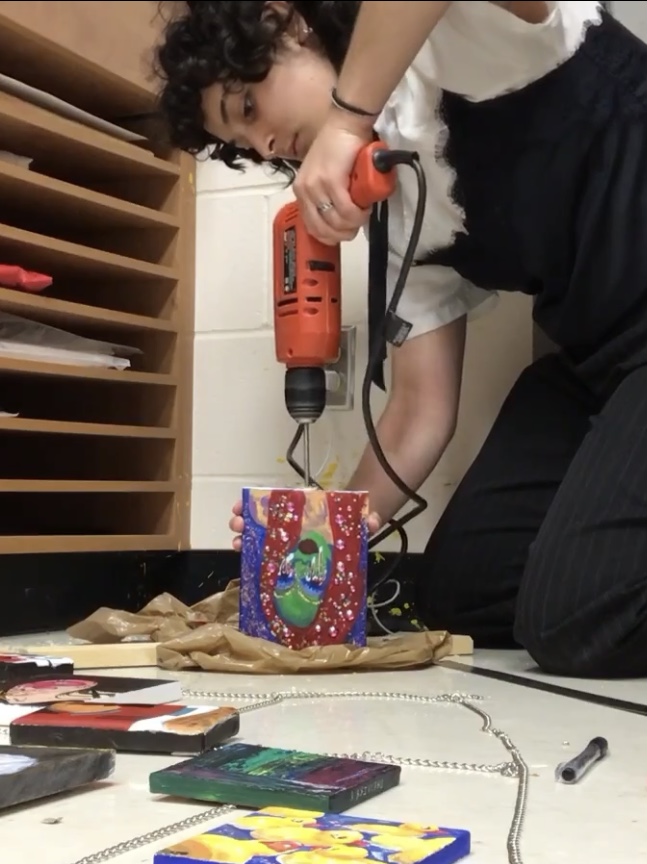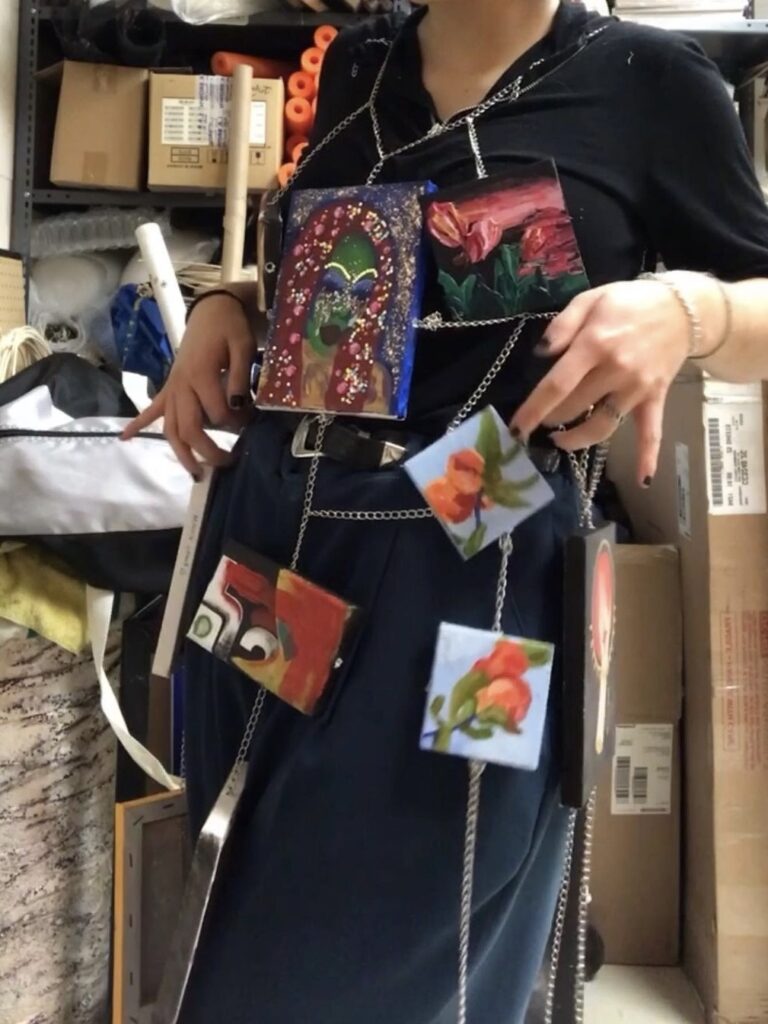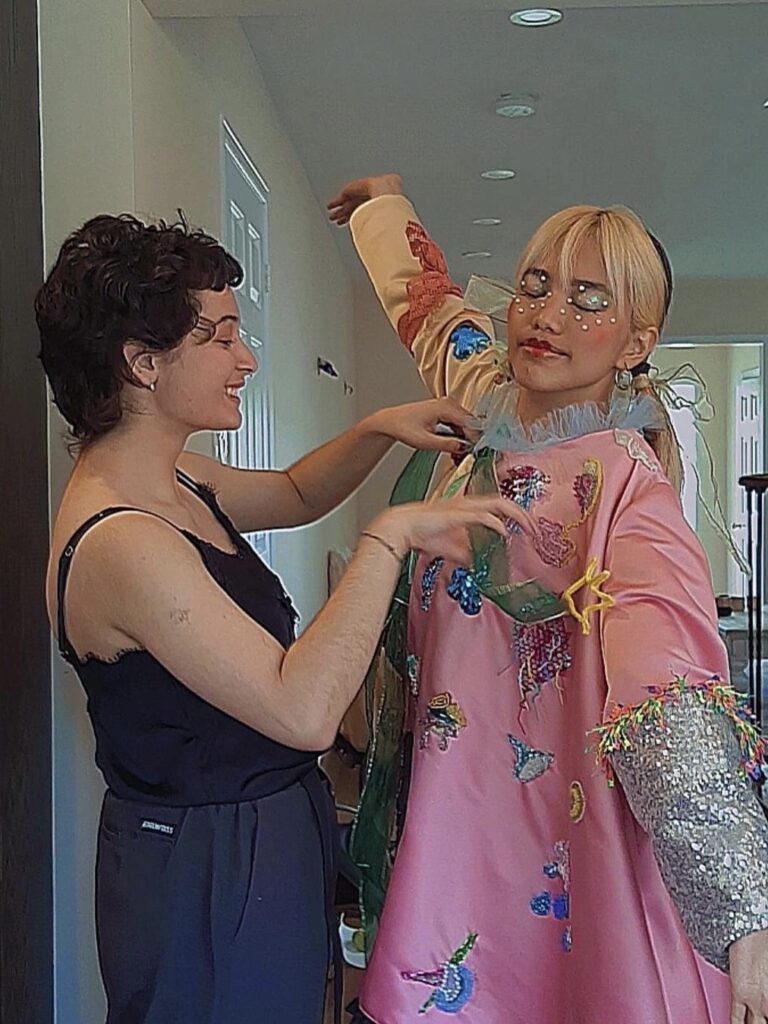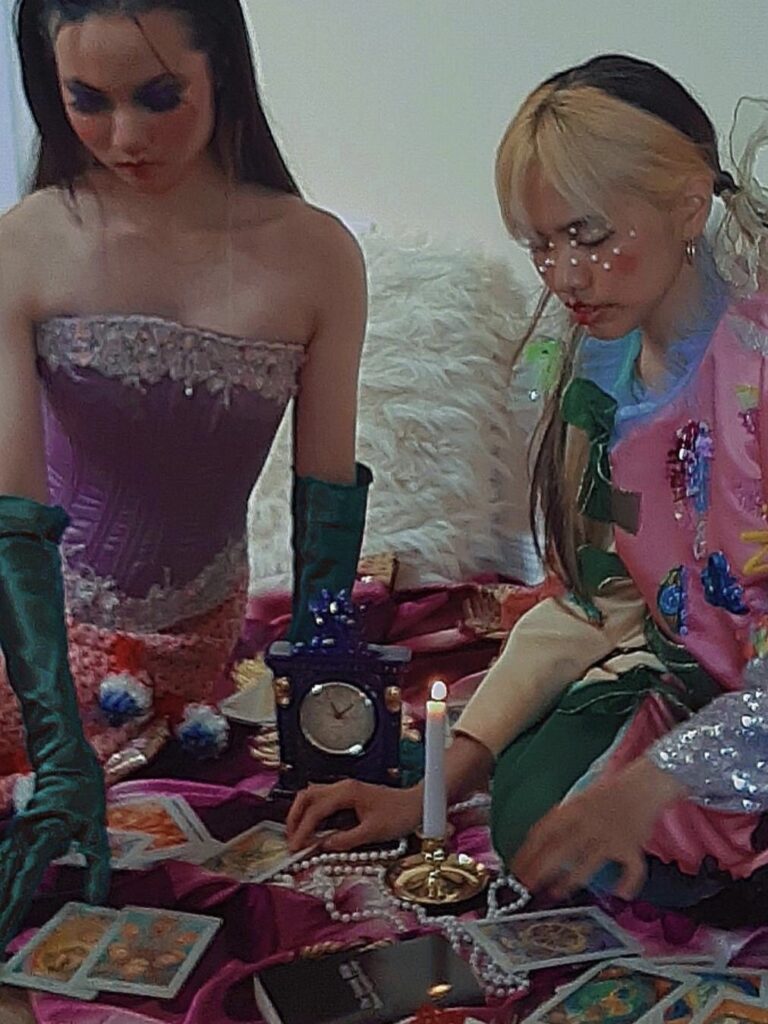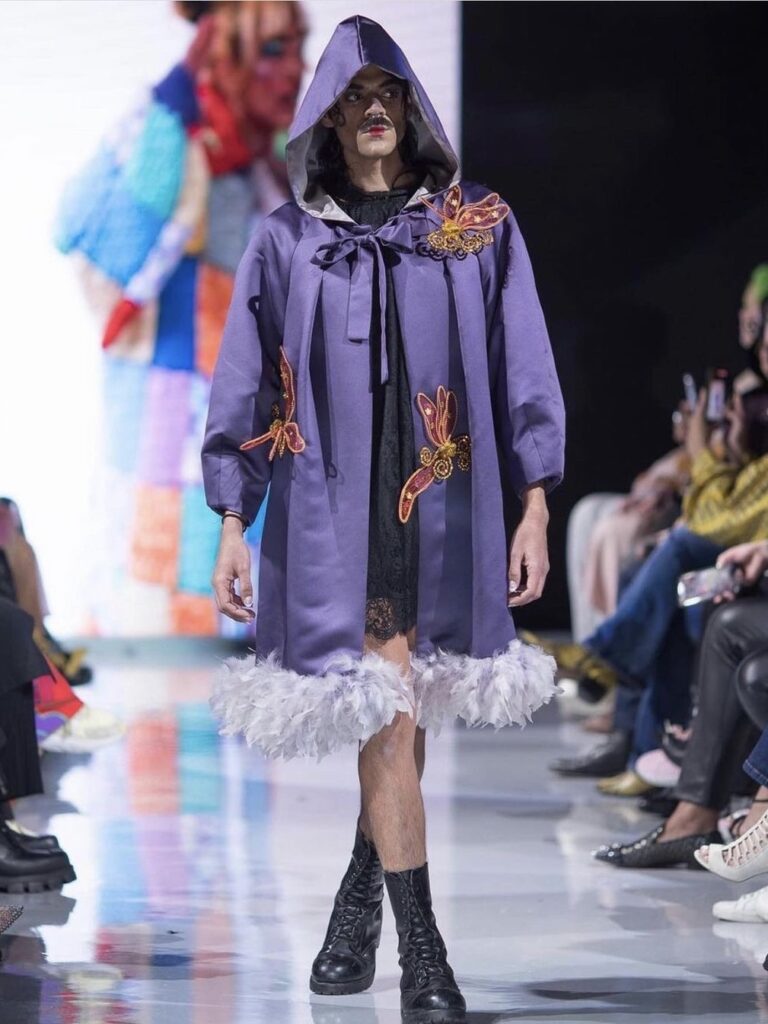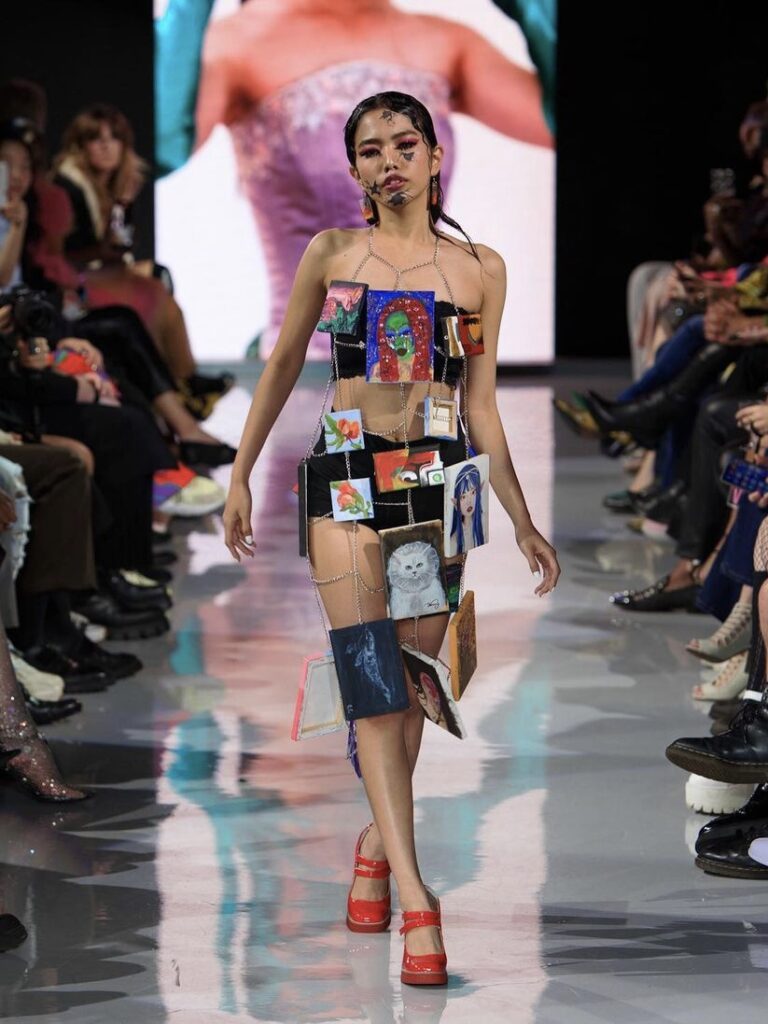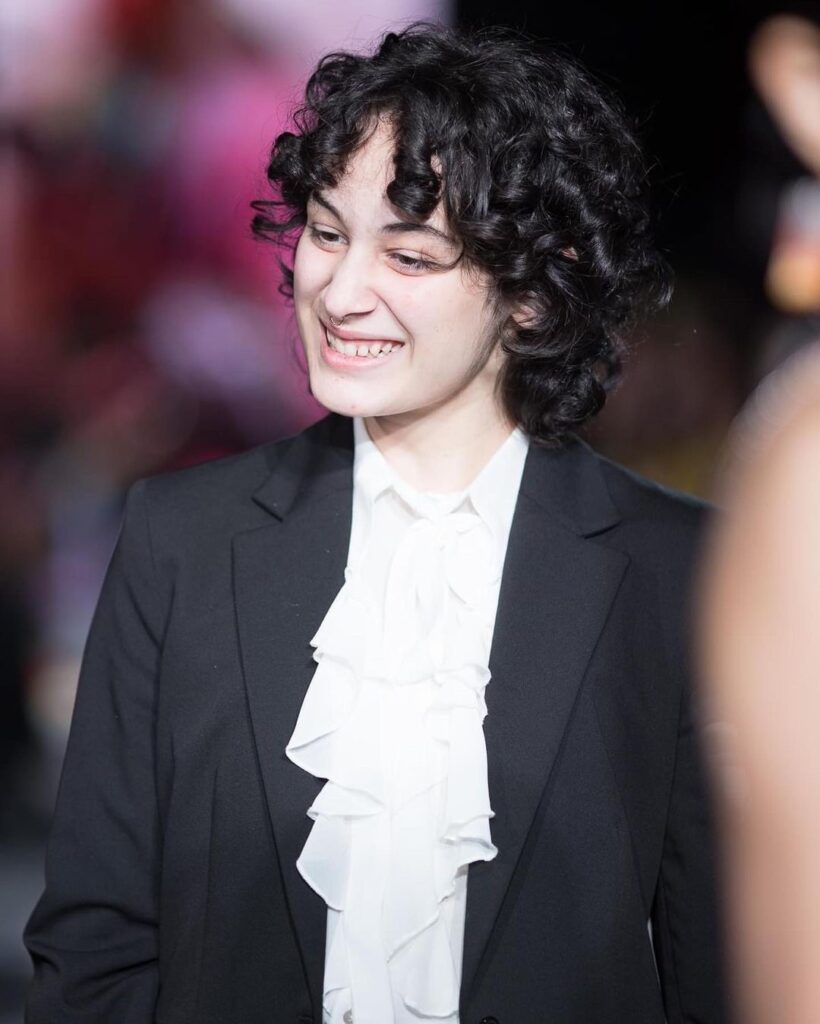By John Vo
“One of the show’s designers is 17-years-old,” whispered someone in the audience. Unbeknownst to her as she was prepping her line-up of models backstage, Prada Lola Faraji, founder and designer of House of Étoile was already garnering attention before her latest collection was even revealed.
Behind the glitz and glamour, and the mob of makeup artists and models, designers like Faraji scrambled backstage to get ready for Fashion Art Toronto’s 2022 fall show. In the dimly lit and confined back area of the illustrious Parkdale Hall venue were two rooms connected by a hallway filled with clothing racks — one room for hair and makeup and the other a change room. Sharing the space with other designers, Faraji anxiously paced back and forth checking hair and makeup and putting the finishing touches on garments, ensuring that the looks matched her vision for the collection. Having arrived eight hours earlier to set up, Faraji knew exactly how she wanted everyone and everything to come together.
Despite all the immense pressure Faraji was experiencing that night, she admits that even stressful aspects of putting on a show, to her, are fun. Not surprising when taking into consideration the years of experience Faraji has under her belt as a designer.
She describes a time when as a free-spirited four-year-old, the tiny and wonderstruck Prada grabbed a sketchbook belonging to her mother. She opened it and smiled as her eyes scanned the clothing illustrations her mother sketched in her free time. The knee-length dresses, items with appliqués and more made her giddy. Seeing how her mother could create intricately detailed designs planted a seed in Faraji’s mind that she could create beautiful things too. “I always followed my mom’s footsteps for a lot of things and we’re very similar in a way,” she says. “I loved styling myself and everything. And just the idea that I can make my own clothes and I can completely make everything from scratch.”
Faraji started sketching dresses and whatever she imagined onto the page eventually drawing and producing her first skirt, made from $3 fabric she found at Fabricland, and she would wear it throughout middle school. Little Prada would continue to play around with creating and modifying her clothes, even selling them occasionally at local boutiques. Nearing the end of her middle school years, starting up a fashion brand became a serious possibility in her mind. It was also during this time that she got to experience new things, having been accepted into the arts program at Alexander Mackenzie High School in Richmond Hill, Ont. and embarking on an exchange program to France. It was on this trip that in between exploring the sights and attractions, the name for her brand suddenly came to her: étoile, the French word for “star.” It spoke to her. Although she jokes about the lack of a deep meaning behind the name, that trip was the inception of House of Etoile.
Starting in 2020, Faraji fully immersed herself in expanding House of Etoile. She mainly utilized her social media to share her current projects, with sporadic appearances at local runway shows and artisan markets. “A lot of my inspiration comes from other Toronto artists and designers. At the time, I didn’t really have a specific person or specific people that I really liked, I just really liked the idea that some people are sustainable and some people are avant-garde.”
However, not every artist has been receptive to her work. Vendors would often ignore or undermine her work due to her age but Faraji says that although that can be disheartening, she chooses to instead focus on the people who uplift her work.
This close connection to the Toronto fashion scene enticed Faraji to apply for Fashion Art Toronto’s (FAT) 2022 fall showcase. The annual multi-day fashion show is where creatives come together to immerse themselves in the collections of up-and-coming Canadian-based designers. Each showcase typically features 30 or more designers sharing their eclectic collections with the fashion community.
“The world is catching up to us in a sense and feeling the nowness and relevancy of the event,” said Vanja Vasic, the founder of FAT. Vasic pointed out that events like hers are important for providing diverse spaces in the fashion community.
Although Faraji already had her work featured in their 2021 online presentation, an organizer of the show assured her the organization wanted her back again. Despite her friend’s encouragement though, self-doubt began to creep into her mind. What if this time she was denied a coveted spot in the event?
Diagnosed with attention deficit hyperactivity disorder (ADHD) and bipolar disorder, managing time between FAT’s schedules, film projects and school became an overwhelming balancing act. “It always keeps me sane, but although that is true, it also affects my mental health so much. Like deadlines and everything in fashion shows are always last minute,” says Faraji.
Faraji says receiving help from resources and loved ones has helped her significantly. Although the journey is not linear and she continues to navigate through life, she says fashion is a healthy outlet to express her inner thoughts. “I feel like if it weren’t for fashion, I wouldn’t be able to have an outlet to put everything that I have together. Yeah, I do think it’s very healing sometimes. Although, it’s literally so chaotic at the same time.” Earning a spot was dependent on just a few preliminary sketches so she sent them in and hoped for the best.
That summer, Faraji was hanging out with her girlfriend at her house in Aurora, Ont. A notification popped up on her phone. Faraji read it and her heart skipped a beat: it was an email from FAT accepting her application as a featured designer. Elated, she went into full gear to finish up her collection, the overarching theme already embedded in her mind. “I really wanted to do something like this because I was getting into magic and occultism, which made me really interested in tarot and mysticism, magic and witchcraft and all that jazz. I had this idea of making a collection that was magically infused for some time.”
Faraji describes egregore as an occultist belief representing the group thought of people. Inspired by tarot cards and man-made gods, the idea for clothing centred on that concept stuck with Faraji early on. This collection also grew out of her personal interests. Citing the innovation of Iris van Herpen and archival Alexander McQueen as influences, Faraji sought to add her trademark flair to these looks.
Her bedroom — with its teal walls, mannequins and shelves filled to the brim with fabrics and sewing supplies — is where Faraji constructed the first few looks for the collection. To Faraji, the simple act of sketching and planning things out differs from her strengths as a creative.“I’m a very hands-on person. I have to fully see something come to life and sketching just doesn’t really do that for me anymore,” she says. The process of brainstorming to complete a project differs a lot for Faraji between projects. At least, compared to other designers. The moment an idea pops into her head, she reaches for the first item that speaks to the look, whether that be a single bead or a yard of fabric. The next step could be anything from cutting fabric into the needed silhouettes to crocheting, the possibilities are endless.
Creating a full look can take days or weeks depending on the material and techniques she’s using. Crochet has long been one of Faraji’s favourite design elements but it is time-consuming. At home or during her free time at school, she’ll be crocheting each yarn thread, inter looping them to form the intended patterns. It can take an entire day to finish a metre of fabric but Faraji says it is worth all the time and effort.
Utilising sustainable materials and practices rooted in repurposing old fabrics has always been a fundamental factor in House of Etoile as a brand. A study conducted by the University of Waterloo this year found that Canadians throw away up to 500 million kilograms of clothing each year. Faraji loved browsing thrift stores, on the hunt for unique used fabrics and clothing she could repurpose for her looks because she knows fashion remains one of the most polluting industries. She makes a conscious decision to opt for ethical practices that in turn help her save money on resources. “It’s big corporations that do most of the polluting, but I just don’t want to be just for my own ethics and morals. I just don’t want to contribute to it.”
One of her favourite looks was the finale look of the show — a dress made entirely of canvas paintings connected with metal chainrings. In the paint-splattered art room of the high school, Faraji spent her free time power-drilling the chains into all the paintings. Some of them were painted by her and the others by her close friends and she says she is immensely honoured that they allowed her to share their beautiful art in this way.
As the show drew closer, Faraji worked to finish all the looks she had conceptualized: the
flowing purple capes, a colourful crochet patches sweater and a floral teal vest were looking
mystical. Every finished seam, hemline and silhouette was the materialization of Faraji’s
imagination and dedication to her craft. With a few looks already done, Faraji was struck with an
Idea: what if she could combine another love of hers with this fashion show? Scenes had begun to form in her mind for a short trailer based on the themes of her runway show: a tarot card, candles lit in the background and mysterious girls. Shot in one day, this marked Faraji’s first time in the director’s chair, an opportunity she revelled in. “You basically have a lot of creative freedom with it. I’m not a big fan of bossing people around but, once in a while, it is a little fun,” she says, laughing.
In the finished piece, featuring half of “Egregore’s” looks, the models wander around a liminal space, surrounded by tarot cards, candles and other witchcraft motifs. One of the starring women in the trailer was Caitleen Sicat, who also donned the final look for the runway. Sicat, an artist and multimedia creative said, “You can really tell how much talent and creativity someone just when meeting them. She has her own world. Just very different from the others, it’s all just very unique.”
In the weeks leading up to the show, Faraji had some difficult decisions to make: picking eight models out of almost 200 choices, selecting the music and the order each look would be presented would seem daunting to anyone but it all went smoothly. “I’m very relaxed with a lot of things so I usually only freak out if something genuinely goes wrong to freak out over, but nothing was really there to be freaking out over. It was great.”
Hundreds of people from all over Canada congregated for FAT’s fall showcase on Nov. 19. Transformed into a sleek white runway straight out of Project Runway, the bright stage lights and EDM background music set the mood for the night. The immense amount of time and money that went into the showcase is all in the precise attention to detail and opulence. The outfits — varying in colours, fabrics from leather patches to voluminous tulle and pieces designer to thrifted — were a kaleidoscope for the eyes.
The lights dimmed, and the audience craned their necks toward the front in anticipation as Faraji’s short film began to play on the projector screen. At that moment, behind the curtain, Faraji knew this was the culmination of all her work and time put into this collection. Set to a whimsical musical track, the models walked one-by-one down the runway in their avant-garde makeup and the finalized looks from “Egregore.” The vibrant patterns and lore embedded into each look captivated the crowd. The models walk out one last time and Faraji followed them out onto the runway and the crowd rose into a standing ovation. “It’s definitely a high just seeing people like that were there to see the show and were able to see the designs. Now that they’re seeing me, that was crazy.”

